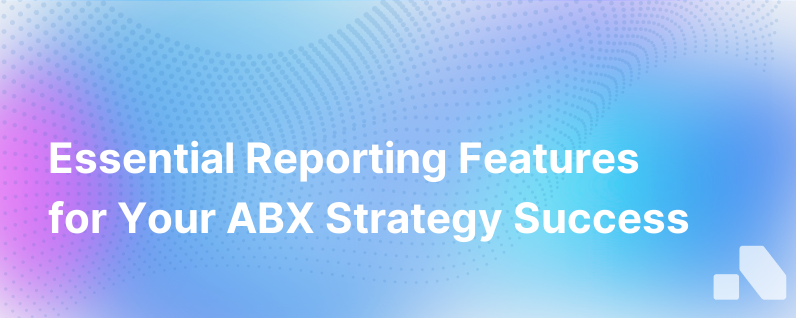
The evolution of Account-Based Marketing (ABM) into Account-Based Experience (ABX) has become a strategic imperative, fostering tailored interactions across the journey at selected high-value accounts. At the heart of a successful ABX program implementation lies robust reporting capabilities, which enable marketers to measure performance and optimize strategy.
Understanding the metrics that matter and the fundamental reporting features to seek is essential for driving Account-Based Experience (ABX) success. Reporting goes beyond basic metrics to encompass the sophisticated analysis necessary for revealing insights, guiding decision-making, and proving ROI to stakeholders.
As you integrate ABX into your overarching strategy, here are 9 must-have reporting capabilities necessary for an effective ABX program:
1. Account-Centric Analytics
ABX requires a pivot from traditional lead-centric metrics to an account-centric approach. Thus, your reporting tool should be adept at tracking metrics at the account level, providing insights into engagement, account progression through the sales funnel, and influence across multiple touches within a specific account.
2. Influence and Impact Reporting
Separating causation from correlation is challenging in any marketing initiative. Reporting for ABX should illustrate not just engagement or reach but also how these activities influence pipeline progression and closed revenue. Such reporting should map touchpoints with accounts to pipeline movement and deal closure, highlighting the impact of specific ABX tactics.
3. Multi-Touch Attribution
In ABX, multiple interactions, often across numerous channels, collaboratively nudge an account toward conversion. Opt for reporting tools with multi-touch attribution capabilities that allocate credit to different marketing activities across different stages of the customer journey, thereby providing a more nuanced view of what's driving results.
4. Engagement Scoring
Engagement scoring in an ABX reporting tool captures account interest and interaction level, aggregating individual lead engagements into an account view. Unlike basic lead scoring, this feature consolidates multiple contacts within an account, scoring by title, frequency, and type of engagement to gauge overall account temperature.
5. Journey Analytics
Account journeys in ABX are not linear. Therefore, a sophisticated reporting tool should enable monitoring and analyzing these journeys, identifying patterns and behaviors indicative of a successful journey. Learn whether accounts are stalling at particular journey stages and intervene accordingly.
6. Content Performance Analysis
Content is critical in ABX, and content performance analysis in your reporting suite helps assess what materials resonate best with target accounts. This insight informs future content creation and distribution strategies, ensuring relevancy and compelling value propositions tailored to specific accounts’ needs and preferences.
7. Funnel Conversion Rates
ABX programs should measure how effectively marketing and sales nurture accounts across each stage of the sales funnel. Reporting tools that visualize and analyze these conversion rates can help diagnose friction points, inform content and campaign adjustments, and forecast future sales cycles more accurately.
8. ROI and Financial Tracking
The bottom line for any marketing program is ROI. Reporting tools must have robust financial tracking and ROI analysis capabilities, tying every dollar spent back to revenue generated. This granular financial tracking is paramount for strategic investment decisions and justifying the ABX program's budget.
9. Benchmarking and Historical Trending
Seeing performance in a vacuum doesn’t offer much value. Your reporting tools should be capable of benchmarking against industry standards and historical trends within your company. Such trend analysis helps assess the health and efficacy of your ABX programs over time and guides you to make iterative improvements.
Creating a Holistic Reporting Ecosystem for ABX
With ABX being a relatively new approach, the reporting capabilities within existing platforms may vary. One solution for this is to harness the power of a unifying platform that seamlessly integrates data from multiple sources. This single source of truth aids in aligning marketing and sales objectives, ensuring that both teams are focused on common goals and informed by the same data when interacting with accounts.
Final Word: Clean, Accurate, Integrated Data is Key
Report accuracy is predicated on data quality. All these reporting capabilities rely on clean, precise, and well-integrated data to provide actionable insights. Having meticulous data hygiene practices and strategies for data integration is crucial for the above reporting functionalities to yield reliable and valuable results.
Ultimately, measurement is the backbone of any data-driven marketing strategy. Incorporating these nine reporting capabilities into your technology stack will empower your ABX program with solid data foundation, and actionable insights allowing for refined strategies, better alignment with sales, and a clearer path to improved ROI.
And while reporting can sometimes feel complex, platforms like Aomni aim at simplifying this for ABX programs by offering integrated solutions that are user-friendly and designed to deliver insights with zero effort required. By focusing on these nine capabilities, and with the right tools, your ABX program can be a highly informed, dynamic and a continually improving sales engine for your organization.